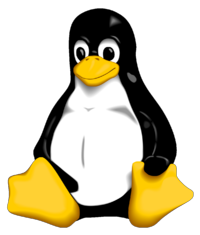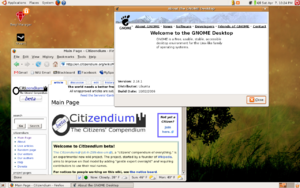Linux (operating system): Difference between revisions
Jump to navigation
Jump to search

imported>Joshua David Williams (added NOTOC) |
imported>Joshua David Williams (beginning re-write) |
||
| Line 18: | Line 18: | ||
| style="padding: 0.25em;"|'''Supported platforms:''' [[X86 architecture|x86]], [[x86-64]], [[ia64]], [[DEC Alpha]], <br/> [[Motorola 68k]], [[SUN Sparc]], [[ARM]], [[PowerPC]] | | style="padding: 0.25em;"|'''Supported platforms:''' [[X86 architecture|x86]], [[x86-64]], [[ia64]], [[DEC Alpha]], <br/> [[Motorola 68k]], [[SUN Sparc]], [[ARM]], [[PowerPC]] | ||
|- | |- | ||
| style="padding: 0.25em;"|'''Kernel type:''' [[Monolithic kernel| | | style="padding: 0.25em;"|'''Kernel type:''' [[kernel module|Modular]] [[Monolithic kernel|monolithic]] | ||
|- | |- | ||
| style="padding: 0.25em;"|'''Default user interface''' (most [[Linux distribution|distros]]): [[Graphical user interface|GUI]] | | style="padding: 0.25em;"|'''Default user interface''' (most [[Linux distribution|distros]]): [[Graphical user interface|GUI]] | ||
| Line 32: | Line 32: | ||
[[Image:Linux_Tux_Logo.png|thumb|200px|right|[[Tux]] the penguin, the Linux mascot]] | [[Image:Linux_Tux_Logo.png|thumb|200px|right|[[Tux]] the penguin, the Linux mascot]] | ||
'''Linux''' is | '''Linux''' is an [[open source software|open source]] [[operating system]]. By strict definition, it is rarely seen by the user, because its job is to be a layer between the user environment and the [[computer hardware|hardware]]. | ||
==References== | ==References== | ||
Revision as of 15:14, 21 April 2007
| Linux |

|
| The GNOME desktop on Ubuntu Linux 6.10 |
| Website: http://www.linux.org (unofficial) |
| Developer: The Open Source community |
| OS family: Unix-like |
| Source model: Open source |
| Supported platforms: x86, x86-64, ia64, DEC Alpha, Motorola 68k, SUN Sparc, ARM, PowerPC |
| Kernel type: Modular monolithic |
| Default user interface (most distros): GUI |
| License: GNU General Public License |
| Working state: Current |

Tux the penguin, the Linux mascot
Linux is an open source operating system. By strict definition, it is rarely seen by the user, because its job is to be a layer between the user environment and the hardware.